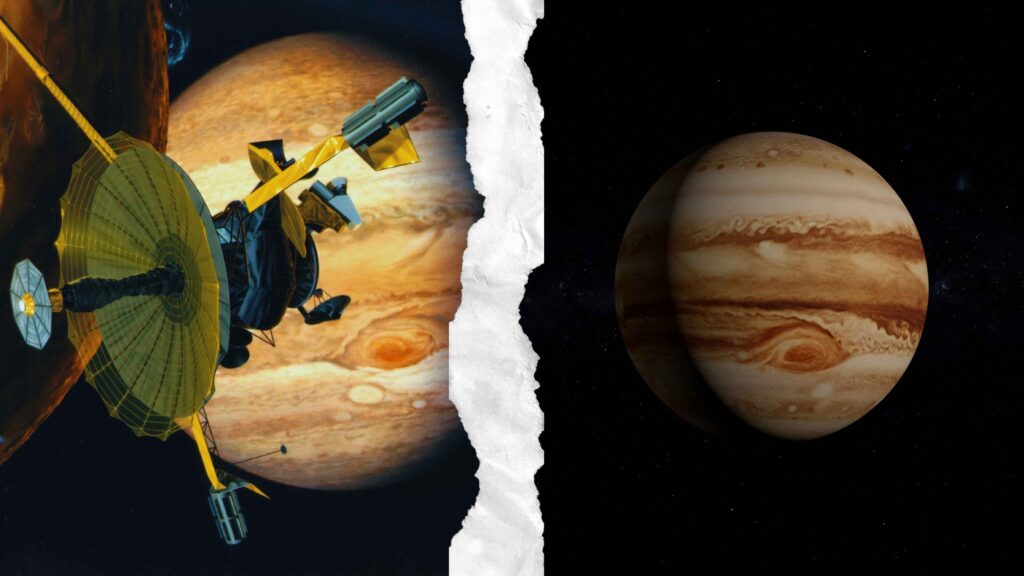Jupiter is the largest planet in our solar system. It is so large that over 1,300 Earths can fit within it! Jupiter is not composed of land like Earth. It is composed primarily of gases such as hydrogen and helium. That’s why we refer to it as a gas giant.
At Anee’s School, one of Mohali and Kharar finest schools, we think that space science can be made easy and fun to learn. Come along with us and discover Jupiter, how it was made, what it is made of, how many moons it has, and the incredible Great Red Spot storm.
How Jupiter Was Formed
Jupiter was created about 4.5 billion years ago. That’s roughly the same time the Sun and other planets were created. When the Sun was giving birth, there was plenty of leftover gas and dust in space. Jupiter began as a small chunk of rock. Gradually, more gas and dust clung to it due to gravity.
Jupiter developed extremely rapidly because it possessed intense gravity. It attracted ever more gas, and that is what made it larger than all the other planets. Since it formed early on, it had longer to get big. That is why Jupiter turned out to be the largest planet in the solar system.
What is Jupiter Made Of?
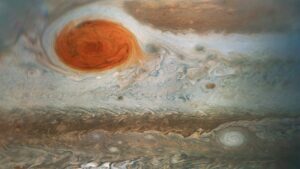
Jupiter isn’t like Earth. It has no land or mountains. Jupiter is composed of heavy gases.
➡️ Hydrogen, mostly (approximately 90%)
➡️ Helium, also (approximately 10%)
➡️ Small traces of methane, ammonia, and water vapor
These gases exist in layers like an onion. The deeper you go in Jupiter, the thicker and warmer the gases become. Scientists think that there could be a tiny, solid center deep within Jupiter, but they don’t know.
You may also like: “Mars: The Red Planet’s Formation, and Possibility of Life”
Jupiter’s Wonderful Atmosphere
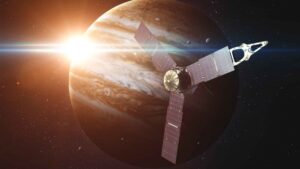
The atmosphere of Jupiter is the most colorful in the solar system. It has stripes running across it. They are referred to as bands and move in opposite directions. The light-colored bands are referred to as zones, while the dark bands are referred to as belts.
These bands are due to extremely strong winds. In fact, there are some winds on Jupiter that move faster than 500 kilometers per hour! That’s quicker than most airplanes.
You can also find storms in the atmosphere. The largest and most well-known one is called the Great Red Spot.
The Great Red Spot – A Massive Storm
The Great Red Spot is a huge storm on Jupiter. It has continued for over 300 years. It resembles an enormous hurricane, but much larger than anything we have on Earth.
➡️ It is twice Earth’s size.
➡️ It rotates like a whirlpool.
➡️ It’s a high-pressure system.
➡️ It is red due to unidentified chemicals in Jupiter’s atmosphere.
Scientists do not know when the storm will end. Some believe it will fade away in a few years, but others suppose it can last even longer.
Does Jupiter Have Moons?
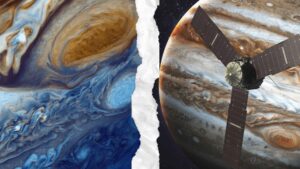
Yes! Jupiter has numerous moons. Indeed, it has 95 known moons, and scientists continue to find more.
The four largest moons are referred to as the Galilean moons, since they were found by the scientist Galileo in 1610.
➡️ Io – Has numerous volcanoes and is extremely hot.
➡️ Europa – Has a smooth, icy surface. It has the possibility of having an ocean beneath the ice where life can be supported.
➡️ Ganymede – The largest moon in the solar system. It is even larger than Mercury.
➡️ Callisto – Has numerous craters and is one of the oldest surfaces in space.
These moons are quite fascinating and unique from one another. Some of them may even have the proper conditions to support life.
You may also like: “The Sun: The Powerhouse of Life in Our Solar System“
Other Cool and Fun Facts About Jupiter
Below are some interesting and fun facts about Jupiter:
➡️ Jupiter rotates extremely quickly. A day on Jupiter is approximately 10 hours long.
➡️ It has a highly powerful magnetic field, far stronger than Earth’s.
➡️ Jupiter also possesses a very weak ring system, though not as large or luminous as Saturn’s rings.
➡️ Jupiter’s gravity is so powerful that it assists in shielding Earth from comets and asteroids by drawing them away.
Why is Jupiter significant?
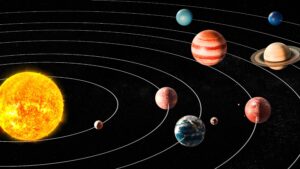
Learning about Jupiter assists astronomers in knowing how planets develop and evolve. Jupiter’s size and intense gravity have influenced the solar system. Other scientists even believe that if there were no Jupiter, the Earth would not be secure against space rocks.
missions such as NASA’s Juno spacecraft are enabling us to better know this enormous world. Juno has photographed beautifully and provided much information about the weather, atmosphere, and magnetic field of Jupiter.
Why Anee’s School Teaches Space in a Fun Way
At Anee’s School, we think learning about space should be fun and simple for all children. We learn about planets such as Jupiter using stories, models, and games.
We also ensure that students ask questions and follow their curiosity. Space science is more than facts. It’s about questioning what is out there and having big dreams!
If you’re searching for the best school in Mohali or best CBSE school in Kharar, Anee’s School is an ideal location for your child to develop and learn in an innovative manner.
Conclusion
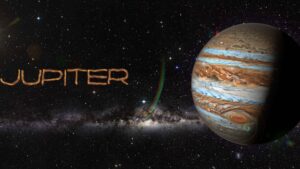
Jupiter is such a fabulous planet. It’s the largest planet in the solar system and it has so many fascinating features such as intense winds, brightly colored bands, numerous moons, and the Great Red Spot. Despite being gas-based, Jupiter does a large amount of helping protect Earth and informing us further about space.
Learning about Jupiter is like embarking on a journey through the stars. At Anee’s School, we welcome all young minds to embark on this journey with us and discover the marvels of our solar system.







